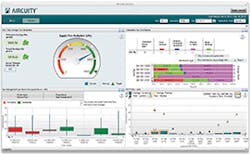Improve Energy Efficiency With Integrated Building Controls
Author Ed Ritchie continues this series on building automation systems technology-a comprehensive approach to building energy management through the implementation of data systems, software applications and centralized computer systems. Whether these applications are adopted for improved energy efficiency or curtailing power consumption (or both), these sophisticated systems shed light on energy management economics producing measurable results. Ultimately, facility managers can make informed power decisions; respond to energy market conditions and manage building automation systems as a company asset rather than wasted energy onsite.
A New Era of Energy Efficiency (Part 2) By Ed Ritchie
BACnet protocol allows HVAC control, lighting control, access control, fire detection systems, and other associated equipment to all speak the same language.
Many utilities are offering incentives to encourage energy efficiency, but they’re also imposing financial penalties to discourage consumption, and this can be critical to the economics of businesses, especially those that need high megawatts, such as data centers that typically require electricity of 10 MW and higher (some exceed 100 MW). According to Mike DeNamur, former vice president of sales and marketing, Automated Logic Corp., Kennesaw, GA, and current VP of Sales and Marketing at AdvanTE3C, a newly formed sister company of Automated Logic, “The dynamics of energy have grown from 10 or 20 years ago. So the decisions are much more complex and the opportunities are greater, but so are the penalties. You can influence your energy consumption to drive revenues or protect yourself from some of the more oppressive utility rate structures and challenges. But if you don’t understand it and don’t prepare, the penalties can be very large.”
To manage consumption, Automated Logic offers a powerful front-end building control software product with a graphical user interface and features that include hierarchical scheduling, thermographic color floor plans, trending, alarm management, and reporting. For detailed reporting, the company’s EnergyReports product enables facility managers to produce a wide array of reports showing a building’s energy consumption. Users can compare energy consumption or demand over different periods with simple drop-down menus and calendar control options.
The new High-Performance Computing Research Center (HPCRC) at Princeton University installed Automated Logic’s WebCTRL Building Automation System to manage energy consumption. The facility is one of only nine high-performance data centers in the world to achieve US Green Building Council Leadership in Energy and Environmental Design (LEED) Gold certification. The 47,000 square-foot facility is home to Princeton’s Terascale Infrastructure for Groundbreaking Research in Science and Engineering, and contains nearly 1,800 computers.
The centralized computing facility features sophisticated heating, ventilation and air conditioning technology, monitored and controlled by ALC’s WebCTRL system. Three chillers maintain water temperature at approximately 45°F to air-cool the computers, which generate excessive heat; the system can switch to outside air during colder months. A natural gas-driven generator, switched on when electricity prices spike, features a cogeneration function that captures expelled heat as a source of energy to chill water. The WebCTRL system provides multiple levels of redundant (N+1) control, backed by extensive trend reporting capabilities.
“You could imagine a scenario where it’s the middle of August and extremely hot, and therefore the electric grid is taxed and there is limited generation capacity, so prices are very high to motivate people to use less energy,” says DeNamur. “What if you could choose not to use energy during those times, and instead pre-cool the building in the morning so it uses less energy in the afternoon, or deploy thermal storage? Temperature control and environmental control is one thing, but is just the tip of the iceberg. You can think about a building as being a place to conduct business, but it’s also a strategic asset that needs to be managed to drive revenues, and reduce costs. But you can’t just put it out there and let the building run in the same operating mode 24/7.”


